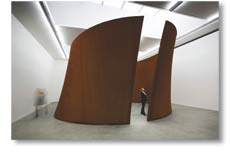|
Richard Serra
 As a teenager I aspired to numerous things. I had ambitions to become an actor, a dancer, a poet, amongst others — but because I spent my entire youth drawing and painting, it seemed obvious that I would become a visual artist. Music entered my life at a relatively late stage. Instead of Richard Serra I could have mentioned other names — Mark Rothko, Paul Klee, Piet Mondrian. However, if I imagine myself as a visual artist, I would like to create works similar to Richard Serra’s. To me, Serra is much more than someone to emulate. As a teenager I aspired to numerous things. I had ambitions to become an actor, a dancer, a poet, amongst others — but because I spent my entire youth drawing and painting, it seemed obvious that I would become a visual artist. Music entered my life at a relatively late stage. Instead of Richard Serra I could have mentioned other names — Mark Rothko, Paul Klee, Piet Mondrian. However, if I imagine myself as a visual artist, I would like to create works similar to Richard Serra’s. To me, Serra is much more than someone to emulate.
Yes, I thought you would go and ask how that is bound up with my music. Serra uses minimal resources: less is more. Although that is not really consonant with my compositions. If you were to compose works like Serra’s how would they sound? Stentorian ambient-minimal for electric guitars and bagpipes that continue to play forever?
What connects me to Serra is the simplicity of the design. In the end, as a composer I aim to create something with as few materials and necessitating as few decisions as possible. Why? I think this has to with my inability to choose. The first remedy for that is to minimize the number of decisions required.
At a certain moment I entered a stage in my life when I was able to overcome that fear of decisions. In ’cross Broadway I used a fairly strict method to determine the harmonic rhythm. First, I rigidly laid down the skeleton of the piece, like some sort of harmonic extract. Next I started to compose based on that structure, and to embellish it. As long as the harmonic rhythm remains intact I allowed myself that freedom. Having done that in a number of pieces I wanted to retrace my footsteps — Riflesso sull’acqua is stricter, back to where I started.
With certain compositions I did not know what the final result would be, such as the music for the radio play Radio I by Samuel Beckett. I composed unconnected parts that were recorded separately, and afterwards superimposed in the studio. Only then did I hear the piece as a whole. I left it like that for it sounded wonderful. What I would have done if I hadn’t liked the outcome? I would have accepted it all the same.
When I am composing, on the one hand I am fascinated by absolute, abstract and on the other hand by programmatic music. Without emulating Beethoven, after writing his programmatic Sixth Symphony (Pastorale) he composed the non-programmatic Seventh. He, too, bounced back and forth between those two extremes.
What John Cage did for music, Joseph Beuys did for the visual arts — both are erroneously heaped together as ‘Fluxus artists’. Cage’s thinking was so free that ‘musical density’ did not play a part in his work. He is the composer of the virtually empty Seven2, as well as of the virtuoso and compressed Freeman Etudes. The same could be said of Beuys. What interests me about his installation Block Beuys is the combination of incredible clarity and complexity. Every object is all-embracing. Every time you walk that collection you notice something new. But he has also created works that are plain and simple.
|